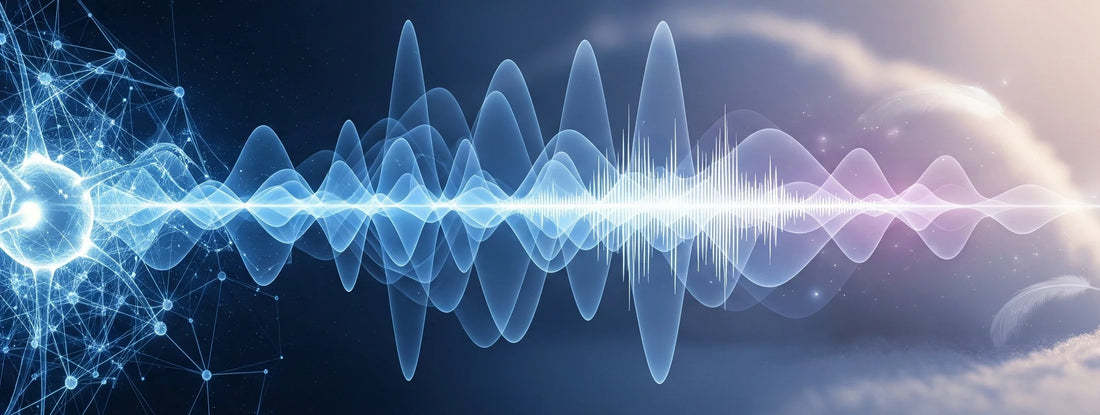
AI-Generated ASMR and the Future of Sound Relaxation
Share
The whispered promises of artificial intelligence have found their way into one of our most intimate experiences: the gentle tingles of ASMR. As neural networks learn to craft soundscapes that trigger our deepest relaxation responses, we're witnessing a fundamental shift in how we consume and create comfort through audio.
The Rise of Algorithmic Calm
AI-powered ASMR represents a fascinating convergence of neuroscience and machine learning. Advanced algorithms now analyze large datasets of successful ASMR content, identifying the precise frequency patterns, rhythmic structures, and tonal qualities that reliably induce those coveted tingles. State-of-the-art models such as Alibaba's ThinkSound and open-source pipelines in Krotos Studio can generate entirely new soundscapes—from the gentle rustling of synthetic leaves to the methodical tapping of virtual fingernails—all calibrated to your personal relaxation preferences.
What makes this technology particularly compelling is its potential for adaptive experiences. In research prototypes and a handful of wellness pilots, AI can adjust tempo, intensity, and even introduce subtle variations in real-time based on biometric feedback or user input. Academic systems such as Autonomous Adaptive Soundscapes (AAS) already re-score audio to heart-rate variability in hospital settings. Imagine an ASMR experience that becomes softer as your heart rate decreases, or one that introduces new textural elements just as your attention begins to wander.
The Promise of Infinite Variety
The most obvious advantage of AI-generated ASMR lies in its inexhaustible creativity. Where human creators might produce one 30-minute session per week, artificial intelligence can generate hours of unique content daily. This abundance means listeners no longer need to repeatedly cycle through the same familiar triggers. High output may help counter habituation—the phenomenon where repeated exposure diminishes ASMR's effectiveness over time—though this hasn't been formally tested.
AI also democratizes ASMR creation, making personalized content accessible to those who might not resonate with mainstream triggers. One-click generators like RunComfy and AIPure let novices create full tracks without microphones or recording experience. Someone who finds traditional whispers ineffective might discover their perfect combination of ambient rainfall mixed with distant keyboard typing—a combination no human creator might have thought to produce.
The technology excels at layering complex soundscapes with mathematical precision. These systems quantize events to the millisecond, useful for binaural or spatial audio effects. Multiple audio streams can be woven together at exact intervals, creating rich tapestries of sound that would be nearly impossible for humans to execute consistently. This technical perfection can produce remarkably immersive experiences, especially when experienced through high-quality earbuds with high resolution that capture every subtle detail the AI has crafted.
The Human Element We're Losing
However, this technological marvel comes with significant trade-offs. The most profound loss is the human connection that has always been central to ASMR's appeal. Media studies show that ASMR viewers form parasocial bonds with their favorite creators—an emotional resonance that purely algorithmic content struggles to match. There's something deeply comforting about knowing another person carefully crafted sounds specifically for your relaxation, an intentionality that AI, despite its sophistication, cannot genuinely replicate.
Human ASMR creators bring personal quirks, emotional authenticity, and the subtle imperfections that make content feel alive. The slight variations in a creator's whisper, the way they naturally pause or emphasize certain words—these human elements create connections that remain uniquely meaningful.
Additionally, AI-generated ASMR often lacks the contextual storytelling and personality-driven content that many listeners cherish. The gentle personal attention scenarios, the feeling of being cared for by a real person, and the parasocial relationships that develop represent aspects of the ASMR experience that remain distinctly human.
Ethical Considerations and Transparency
As this technology proliferates, questions arise about disclosure and authenticity. Should listeners know when their relaxation content is artificially generated? The debate mirrors broader conversations about AI transparency across media, with some advocating for clear labeling while others argue that effectiveness matters more than origin.
The Future Soundscape
As AI technology continues advancing, we're likely to see hybrid approaches that combine artificial intelligence's technical capabilities with human creativity and emotional intelligence. Some creators are already experimenting with AI-assisted production, using algorithms to generate base soundscapes that they then personalize with human touches—overlaying their own whispers onto AI-generated beds to restore intimacy while leveraging computational precision.
This evolution reflects a broader trend toward personalized, adaptive media consumption. Just as streaming algorithms curate music playlists tailored to our moods, AI-generated ASMR represents the next step toward truly individualized relaxation experiences.
The future of sound relaxation isn't about replacing human creators with machines, but rather expanding the possibilities for how we access and experience comfort through audio. As this technology matures, it promises to make quality relaxation content more accessible, diverse, and precisely calibrated to our individual needs—a testament to how innovation can enhance our most fundamental human experiences with rest and peace.
